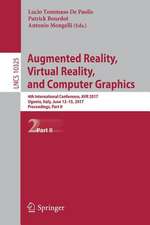Deep Learning through Sparse and Low-Rank Modeling: Computer Vision and Pattern Recognition
Autor Zhangyang Wang, Yun Fu, Thomas S. Huangen Limba Engleză Paperback – 12 apr 2019
This book will be highly useful for researchers, graduate students and practitioners working in the fields of computer vision, machine learning, signal processing, optimization and statistics.
- Combines classical sparse and low-rank models and algorithms with the latest advances in deep learning networks
- Shows how the structure and algorithms of sparse and low-rank methods improves the performance and interpretability of Deep Learning models
- Provides tactics on how to build and apply customized deep learning models for various applications
Preț: 434.58 lei
Preț vechi: 627.98 lei
-31% Nou
Puncte Express: 652
Preț estimativ în valută:
83.18€ • 86.51$ • 69.70£
83.18€ • 86.51$ • 69.70£
Carte tipărită la comandă
Livrare economică 06-20 martie
Preluare comenzi: 021 569.72.76
Specificații
ISBN-13: 9780128136591
ISBN-10: 0128136596
Pagini: 296
Dimensiuni: 191 x 235 x 17 mm
Greutate: 0.51 kg
Editura: ELSEVIER SCIENCE
Seria Computer Vision and Pattern Recognition
ISBN-10: 0128136596
Pagini: 296
Dimensiuni: 191 x 235 x 17 mm
Greutate: 0.51 kg
Editura: ELSEVIER SCIENCE
Seria Computer Vision and Pattern Recognition
Cuprins
1. Introduction2. Bi-Level Sparse Coding: A Hyperspectral Image Classification Example3. Deep ℓ0 Encoders: AModel Unfolding Example4. Single Image Super-Resolution: FromSparse Coding to Deep Learning5. From Bi-Level Sparse Clustering to Deep Clustering6. Signal Processing7. Dimensionality Reduction8. Action Recognition9. Style Recognition and Kinship Understanding10. Image Dehazing: Improved Techniques11. Biomedical Image Analytics: Automated Lung Cancer Diagnosis





























